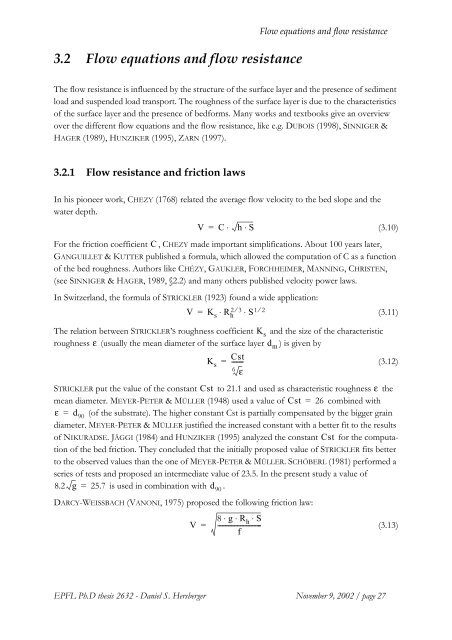pdf, 12 MiB - Infoscience - EPFL
pdf, 12 MiB - Infoscience - EPFL
pdf, 12 MiB - Infoscience - EPFL
Create successful ePaper yourself
Turn your PDF publications into a flip-book with our unique Google optimized e-Paper software.
3.2 Flow equations and flow resistance<br />
Flow equations and flow resistance<br />
The flow resistance is influenced by the structure of the surface layer and the presence of sediment<br />
load and suspended load transport. The roughness of the surface layer is due to the characteristics<br />
of the surface layer and the presence of bedforms. Many works and textbooks give an overview<br />
over the different flow equations and the flow resistance, like e.g. DUBOIS (1998), SINNIGER &<br />
HAGER (1989), HUNZIKER (1995), ZARN (1997).<br />
3.2.1 Flow resistance and friction laws<br />
In his pioneer work, CHEZY (1768) related the average flow velocity to the bed slope and the<br />
water depth.<br />
V = C⋅<br />
h ⋅ S<br />
(3.10)<br />
For the friction coefficient C , CHEZY made important simplifications. About 100 years later,<br />
GANGUILLET & KUTTER published a formula, which allowed the computation of C as a function<br />
of the bed roughness. Authors like CHÉZY, GAUKLER, FORCHHEIMER, MANNING, CHRISTEN,<br />
(see SINNIGER & HAGER, 1989, §2.2) and many others published velocity power laws.<br />
In Switzerland, the formula of STRICKLER (1923) found a wide application:<br />
V = K s<br />
⋅ R2 3<br />
h<br />
⋅<br />
⁄ S 1⁄<br />
2<br />
(3.11)<br />
The relation between STRICKLER’S roughness coefficient K s<br />
and the size of the characteristic<br />
roughness ε (usually the mean diameter of the surface layer d m<br />
) is given by<br />
K s<br />
=<br />
Cst<br />
-------<br />
(3.<strong>12</strong>)<br />
6<br />
ε<br />
STRICKLER put the value of the constant Cst to 21.1 and used as characteristic roughness ε the<br />
mean diameter. MEYER-PETER & MÜLLER (1948) used a value of Cst = 26 combined with<br />
ε = d 90 (of the substrate). The higher constant Cst is partially compensated by the bigger grain<br />
diameter. MEYER-PETER & MÜLLER justified the increased constant with a better fit to the results<br />
of NIKURADSE. JÄGGI (1984) and HUNZIKER (1995) analyzed the constant Cst for the computation<br />
of the bed friction. They concluded that the initially proposed value of STRICKLER fits better<br />
to the observed values than the one of MEYER-PETER & MÜLLER. SCHÖBERL (1981) performed a<br />
series of tests and proposed an intermediate value of 23.5. In the present study a value of<br />
8.2 g = 25.7 is used in combination with d 90 .<br />
DARCY-WEISSBACH (VANONI, 1975) proposed the following friction law:<br />
V =<br />
8 ⋅g ⋅R h<br />
⋅ S<br />
----------------------------<br />
f<br />
(3.13)<br />
<strong>EPFL</strong> Ph.D thesis 2632 - Daniel S. Hersberger November 9, 2002 / page 27
















